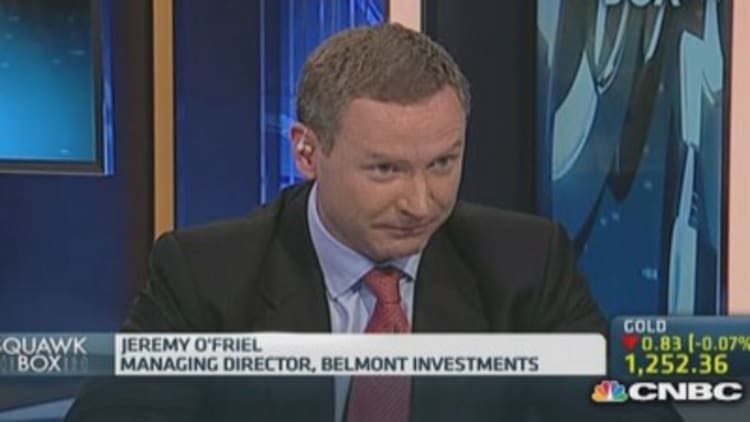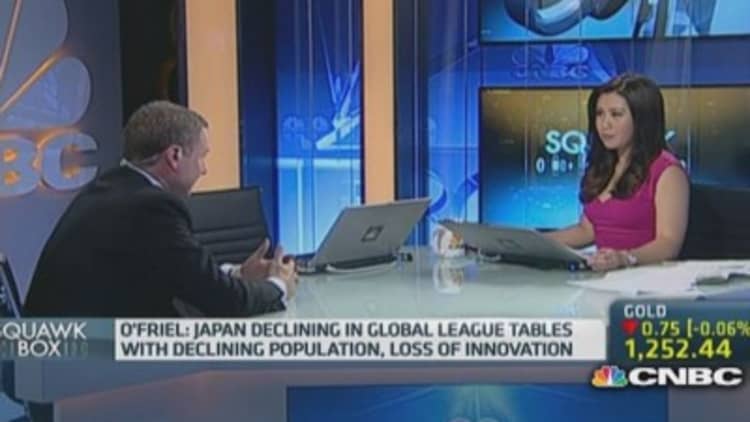
U.S. Treasury yields, not far off 11-month lows, could fall further, possibly even matching Japan's perennially low-yielding government bonds, an analyst said.
Yields everywhere may be "surprisingly low," but "I think that they'll go even lower," Jeremy O'Friel, managing director of alternative investment manager Belmont Investments, told CNBC.
Read More How long can Treasury yields stay this low?
"You're looking at the U.S., Japan [and] Germany -- three countries that, let's face it, are not going to default in the next 10 years," while at the same time, they're likely to keep interest rates at effectively zero for at least two to three more years, he said.
If the risk is essentially the same, "there's no reason why bunds and U.S. Treasurys shouldn't go to that level," of Japan government bonds (JGBs) as asset managers push more money into the higher-yielding bonds, he said.
"Let's say you're sitting on a billion dollars that you don't want to risk for a pension fund or an endowment and your choices are sticking it in a bank or sticking it into bonds," he said. "U.S. bonds, I think, don't create an awful lot more risk than your average bank. So to take 2.5 percent right now versus virtually zero I think is a very good trade."
While many analysts have called for U.S. Treasury yields to rise in the wake of the U.S. Federal Reserve tapering its asset purchases, yields instead declined, with the 10-year touching an 11-month low of 2.44 percent last month, well off highs of around 3.0 percent touched in early January. In Asia trading Monday, the yield was at 2.61 percent.
It's well above the 10-year JGB yield, which has been stuck under 0.65 percent since January and hasn't traded over 1 percent since the middle of 2012. The picture isn't much different in Germany, where the is around 1.36 percent and hasn't traded above 2 percent since September.
Read More This is what is keeping bond yields low
To be sure, expecting U.S. Treasury yields to fall further is a non-consensus view on its own and expecting them to match JGBs is even further afield.
"The reason why JGB yields and U.S. Treasury yields should not be the same is because the growth trajectory is different," said Mark Matthews, head of research for Asia at Julius Baer.

"Japan's economy never really recovered for 20 years. It continued to stumble along," he said. "The U.S. economy is recovering. It's patently obvious from the data," he added, citing last week's employment data.
Nonfarm payrolls data Friday showed the U.S. added 217,000 jobs in May, in line with expectations, with the unemployment rate at 6.3 percent.
Read More Whatever happened to the great rotation?
O'Friel, however, doesn't believe the data is still a bit of a drag, with the economy only now getting back to break even on an absolute basis with the pre-financial crisis levels and it still lags when population growth of around 3 percent is included.
"We're still 7-9 million jobs short of full recovery," he said.
At the same time, on the Japan side, O'Friel isn't as convinced that its economy is necessarily an underperformer.
"We hold Japan to an impossible standard," O'Friel said. Japan's economy grew to become No.2 globally, before slipping back to No.3, he noted.
"When people talk about recovery, they talk in league table terms of how do they get back to where they once were. They won't," he said, citing headwinds from a declining population and slower productivity growth.
But O'Friel noted the U.K. was once the biggest economy globally, but now ranks fifth or sixth. "To not get back to number one or number two isn't necessarily a failure."
Read More Recent bond-yield creep is start of something: Pros
But there may be another obstacle to U.S. Treasury yields dropping around 2 percentage points to match JGBs: they've simply never been that low before.
U.S. Treasurys' absolute lowest yield in the midst of the Federal Reserve's latest incarnation of quantitative easing --which it is currently in the process of tapering -- was around 1.5 percent, Matthews noted.
—By CNBC's Leslie Shaffer. Follow her on Twitter @LeslieShaffer1

